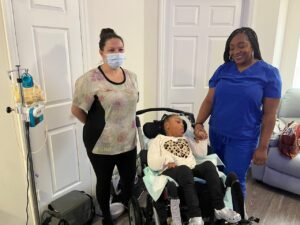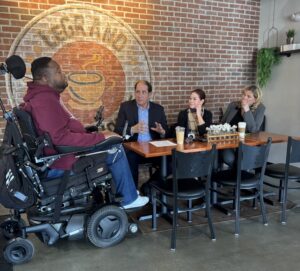Last Tuesday voters took the polls in droves. The high turnout rate—one we haven’t seen for a midterm election in half a century—was driven by strong opinions of President Trump and competitive races that dotted the whole country. But what does the election mean for the future of health care—and home care—in the US? 
Key Takeaway 1: Health care is beginning to mean a whole lot more to US citizens
Exit polls around the country proved that Americans care about health care, and they want their legislators to care too. 41 percent of voters participated in exit polling around the country cited health care as the number one issue they considered when they made ballot decisions. This was the number one issue cited, with immigration trailing at 23 percent and the economy at 21.
This prioritization contributed to Democrats’ success in flipping the US House of Representatives from red to blue. Democrats around the country campaigned on a vow to protect the 130 million Americans currently living with pre-existing health conditions and to lower prescription drug costs. While some candidates ran on a more aggressive health care-focused platform than others, the election results make it clear that Americans care about health care and that Republicans’ threats to cut Medicaid and Medicare funding and rollback the Affordable Care Act (ACA, also widely known as Obamacare) was not taken lightly by voters.
This victory puts Democrats in a better position to test the far-reaching health care agenda they have campaigned on for over a year, though any resulting legislation will likely be curtailed by the Republican-held Senate and White House.
Key Takeaway 2: Medicaid Expansion is among Tuesday’s biggest winners
The people have spoken, and they’ve said one thing loud and clear: You cannot block our access to expanded Medicaid. Through ballot measures and new blood in several states’ Governors’ mansions, Obama’s Medicaid expansion will get even bigger in the coming years.
Voters in three deeply red states—Idaho, Nebraska, and Utah—approved ballot measures that specifically called for Medicaid expansion. These measures acted as a tool to gain access to expansion funding despite state lawmakers’ resistance of the optional program. Voters in Montana, which currently has Medicaid expansion, rejected a ballot measure that would have permanently funded the program beyond its June 2019 expiration date. However, Republican state lawmakers have said they want to continue the program with new work requirements.
In addition to ballot measures, the election of new democratic governors bodes well for expansion in three additional states: Kansas, Maine, and Wisconsin, where newly-elected governors have already expressed their support of expansion.
Together, these elections will likely bring the largest growth to Medicaid expansion since the ACA’s early days. At minimum, three states will join the 36 states and Washington, D.C. that have already opted for expanded Medicaid dollars.
To recap the expansion program: In 2014 Medicaid expansion under the ACA became an option for states. 24 states and D.C. opted for it immediately and by mid-2016, an additional seven states signed on. Since then, no additional state has signed on, likely due to resistance from lawmakers in those states. Medicaid expansion allows for more individuals who are above the poverty line to access Medicaid care. The expansion makes financial sense to states who want to provide care for more of their citizens: The federal government covered 100 percent of expansion costs through 2016, currently covers 94 percent of those costs, and will cover 90% in 2020 and beyond. Currently, without the addition of new states, the program allows for 13.6 million people to access Medicaid that could not access it prior to expansion.
Read more about the election’s implications for Medicaid expansion, and about studies that point to the expansion’s effects, read the Kaiser Family Foundation’s take.
Key Takeaway 3: Home care champion US Rep. Frank Pallone is about to be in a health care leadership position
Health care was a hot topic in this election, and Democrats put it at the forefront of their campaigns. Now its up to longtime NJ congressman Frank Pallone to help Democrats keep the promises they made to voters.
In January, Rep. Pallone will take over at the helm of the House Energy and Commerce Committee—a powerful committee that sees approximately 60 percent of bills before they move forward to a floor vote. As leader of this committee, Pallone will be in the center of the much-anticipated, high-volume health care debate, which will in turn form the backdrop of 2020’s presidential race. He will essentially hold the gavel over the Democratic party’s health agenda and will set the tone on named priorities like protecting and strengthening the ACA, and lowering prescription drug costs.
Pallone, who was elected to his 16th term during this election, is well-informed on home care and its impact and importance to millions of Americans across the country. He also understands the potential financial benefits that home care has on state and federal bottom lines. While the partisan tug-of-war over the ACA is likely to take center stage over the coming few years, the home care industry is excited and hopeful about what this leadership position may mean for the future of in-home health care.
Key Takeaway 4: Home care is making a name for itself
Voters in Maine shot down a proposal to create a universal home care program, but there are positive implications: Home care gained awareness on the national front due to the initiative. The proposal, known as “Question One,” would have provided free home-based care to adults over 65 and to individuals in the state living with disabilities. To fund the initiative, Question One proposed a tax on high-income households.
While the measure garnered a great deal of opposition and controversy, home care supporters tout that this first-of-its-kind measure raised awareness of home care and served as a case study for future home care initiatives across the US. “We are incredibly proud of the hundreds of volunteers who placed universal home care on the ballot…We’re also proud to have put Maine’s home care crisis front and center in the public debate,” Yes on One Campaign Manager Ben Chin said in a statement.
Not far from Maine, an unrelated “Question One,” which would have been detrimental to home care providers in the state, failed to woo voters. The proposal would have imposed ratios limiting the number of patients that could be assigned at a time to individual nurses at hospitals and health clinics.
This proposal, which was sponsored by a state nurses union, created a divisive battle. Hospital groups, home care providers, and even fellow nurses, united to push back against the measure—and succeeded. In the end, the union’s view that nurse-patient ratios offer increased patient safety lost out to the opposition, which proved to voters that the “one-size-fits-all” approach increases costs and puts undue pressure on hospitals and other settings, including home care and other post-acute settings that are reimbursed at lower rates. To hear more about how MA’s Question One would have impacted home care, listen to the Home Care Alliance of Massachusetts’ podcast.
Maine and Massachusetts’ battles prove that public awareness and support around home care is growing, and that the nation’s projected home care crisis is more widely-known. The more home care makes it to the public sphere, the better-positioned it is to be acted upon and prioritized at both state and national levels.







